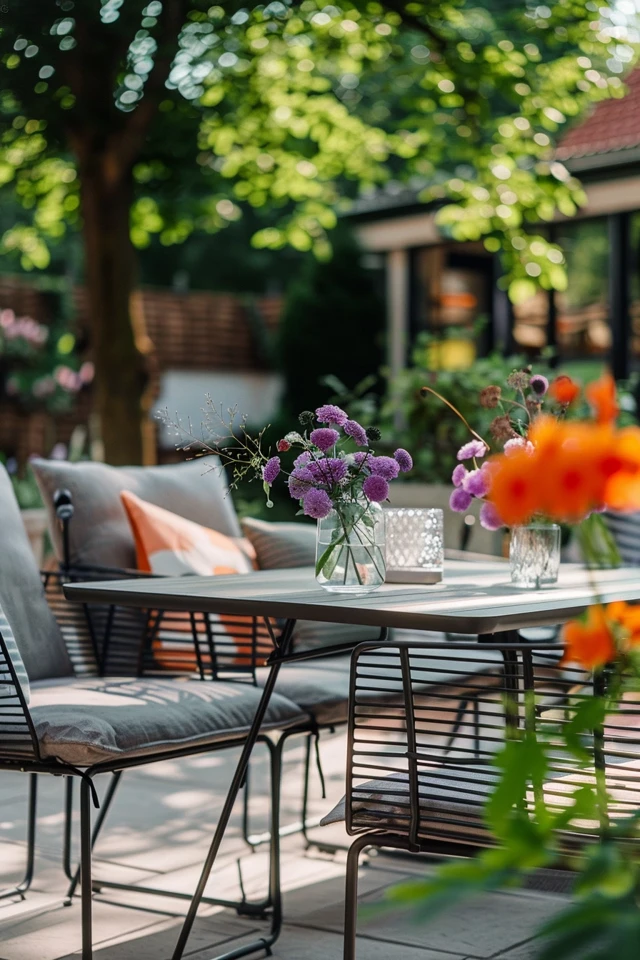Gorgeous metal patio furniture can be a stunning addition to any outdoor space. However, over time, exposure to the elements can cause the metal to become oxidized and lose its shine. To restore your furniture to its former glory, it’s essential to clean and maintain it regularly. In this article, I will provide you with valuable tips on how to clean oxidized metal patio furniture and restore it to its original beauty.
Key Takeaways:
- Regular cleaning is crucial for maintaining the appearance and longevity of your outdoor metal furniture.
- Avoid using alkaline cleaners as they can cause oxidation; instead, opt for non-abrasive cleaners like Soft Scrub for scuff marks on aluminum furniture.
- For removing oxidation from metal furniture, a mixture of white vinegar and water or a metal polishing paste can work wonders.
- Rusty iron furniture can be sanded, primed with rust-resistant primer, and painted with rust-resistant paint for long-lasting results.
- Professional restoration services like sandblasting and powder-coating can provide a durable finish for your metal furniture.
By following these restoration tips, you can bring back the shine and splendor to your oxidized metal patio furniture, ensuring that it remains a focal point of your outdoor space for years to come.

Preventing and dealing with oxidation in metal furniture
Preventing oxidation in metal furniture is essential for maintaining its appearance and increasing its longevity. Here are some tips to help you protect your metal furniture and deal with oxidation:
- Choose corrosion-resistant materials: When purchasing metal furniture, opt for materials like aluminum or stainless steel that are less prone to oxidation.
- Apply protective measures: Create a barrier against oxidation by painting the furniture, powder coating it, using sealants or repellents, and regularly waxing it.
- Regular cleaning: Clean your metal furniture regularly with warm water, soap, and a scrub brush to prevent the buildup of dirt and grime, which can accelerate oxidation.
- Removal of severe oxidation: In case of severe oxidation, you can try dusting the furniture with baking soda, soaking it in vinegar, or using a mixture of salt and lemon to remove the oxidation.
- Professional restoration services: If refurbishing the metal furniture at home is not feasible, consider professional restoration services like Metal Furniture Doctor, who can provide effective solutions for dealing with oxidation.
- Specific cleaning techniques: Different metals may require specific cleaning and maintenance techniques to prevent and deal with oxidation effectively. Be sure to research and follow the appropriate care instructions for your specific type of metal furniture.
By taking proactive steps to prevent oxidation and promptly addressing any signs of oxidation, you can protect your metal furniture and ensure it remains in excellent condition for years to come.
Remember:
“Prevention is key when it comes to dealing with oxidation in metal furniture. Regular cleaning, protective measures, and choosing the right materials can go a long way in preserving the beauty and integrity of your outdoor furniture.”

Cleaning and maintaining other types of outdoor furniture
When it comes to keeping your outdoor furniture in top shape, cleaning and maintenance play a key role. Whether you have plastic furniture, glass tabletops, wicker and wood furniture, or outdoor cushions, proper care is essential to ensure their longevity and appearance.
To clean plastic furniture, avoid harsh cleaners and abrasive materials that can cause damage. Instead, opt for mild cleansers mixed with water for colored plastic furniture, while warm water with dishwasher detergent works well for white or light-colored plastic. Stubborn stains can be tackled with shaving cream, white distilled vinegar, or baking soda.
When it comes to glass tabletops, it’s important to use glass-safe cleaners and non-abrasive materials to prevent scratching. Regular cleaning of wicker furniture with warm water and a hose can prevent dust buildup in crevices, while wood furniture should be wiped down regularly with mild oil-based soap or a mixture of ammonia and white vinegar. For weather-beaten wood, a gentle cleaning with dishwashing detergent followed by conditioning with vegetable oil can help restore its beauty.
Outdoor cushions should be cleaned according to their specific care instructions, using mild detergents and proper rinsing. White fabric can be treated with bleach, while colored fabric should be washed with color-safe, non-chlorine bleach or oxygen bleach. Additionally, applying automotive paste wax can provide protection and enhance the appearance of metal and teak furniture.


